The loch was – we wild swimmers don’t use the ‘C’ word – so let’s call it invigorating. I got out of the water to change on the pebbly shore and, in the moment of nearsightedness in between changing my prescription goggles for specs, I put my towel and goggles down in a pile of human shit. The drive home in wet swimming gear with a stinking towel in a plastic bag in the boot was unpleasant to say the least. There had been no attempt to bury the waste, to place stones on top or anything. Perhaps this personal experience contributed something to my conclusion that the management of tourism in the Highlands this summer has been something of a shit show.
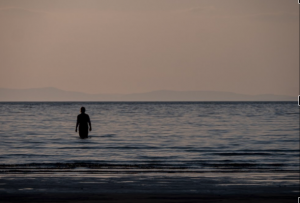
Tourism is like a river that flipped its course. From the Johnsons’ badly-pitched yurt to superyachts to the fitness guru Joe Wicks, North has been the direction of travel this late summer instead of south. The upside is that many businesses which depend on tourism in the Highlands have had a good few weeks – and have adapted – often with creativity and grace – to challenging restrictions. The downside is that the area is simply not geared up to deal with the numbers. And while most campers behave well, the rush of people brings some who don’t understand even the basics – when we visited a pony trekking centre we heard that campers had left off fireworks on the beach and terrified the animals – one was injured trying to escape.
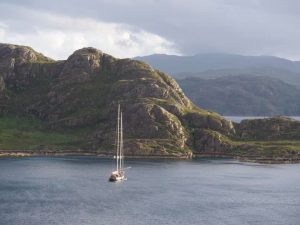
Superyacht Athos
Government agencies have failed to manage the situation constructively. Both Nicola Sturgeon and Boris Johnson exhorted people to holiday close to home this year. Yet too many people who tried to get away for a much-needed break found a widespread lack of facilities. Supporting farmers to offer very basic managed wild camping sites – a couple of fields with portaloos, as Tory MSP Edward Mountain suggested midway through the pandemic – would have transformed the experience.
Of course, it is hard to shift capacity overnight – Edinburgh, which normally absorbs vast number of visitors, echoed to the sound of seagulls and silence this summer. But It was predictable that people would want to escape to the wilderness after lockdown. More could have been done, and planning for next year should start now.
Loved to Death
The unaccustomed numbers have undeniably created issues that are difficult to solve in particularly popular areas. Parts of the Highlands have looked more like the Lake District in high season recently. At many top-ranking Munros there isn’t much parking – or any toilets. Cars parked at the side of narrow roads can cause issues. One of our neighbours spoke to someone who was parking dangerously – he said: “I don’t believe lorries come up this road!”
Ben Nevis is apparently in danger of being “loved to death” and the John Muir Trust is demanding permits be issued to climbers. Teacher Janet Morrison on a recent trip with her husband and sons found it crowded. She wrote in a Facebook post: “As a last hurrah before going back to school, we threw camping gear in the car and headed for Ben Nevis on Saturday morning. It was a great idea but it also occurred to half of Glasgow and many other varieties of hill-climbing humans and some who maybe shouldn’t. Because we were a late start on the hill (noon for a 7 hour walk), we hadn’t realised just how many others had already headed up until about 2 1/2 hours in when it became clear we should have picked a different mountain.
“At this point, we were obviously heading against the current of people now returning. Climbers, runners, folks swigging Buckfast, some providing their own soundtrack, charity walkers, people who looked seriously unlikely candidates and others who seemed like this little hillock would not be enough challenge for the day. Honestly, I’ve been in rush-hour subway stations less crowded. As for COVID exposure, I expect that we might as well have been licking an empty glass from a pub in Aberdeen. Still it was amazing. The top had cleared out and I’m glad we didn’t have to share it with quite so many people as must have been up there earlier.
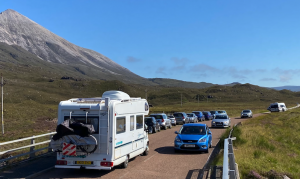
Party campers
Some behaviour is concerning. We have all seen those photos of litter left behind by party campers; and sites on social media report people damaging trees for firewood, On a visit to the Gairloch Trekking Centre at Redpoint Beach, we heard that beach campers had let off fireworks near fields of horses, injuring a pony. Owner Danielle Warren said: “We have had 19 years of lovely people camping here but this year we have had a lot of problems. Some people in a campervan had a fireworks party on the beach the other night and it startled the horses. A little dapple grey pony we have called Cadence was injured because she got such a fright. She started jumping over ditches in the dark trying to get away and she injured her forelock. She is recovering but she was spooked by it and she is still very nervous. All the livestock were frightened – there were sheep and cows grazing around the beach. I don’t know who would let off fireworks in fields next to horses.”
Danielle also had to deal with a campervan emptying the greywater into a ditch by the horses’ field and finding beer bottles thrown over the fence into it.
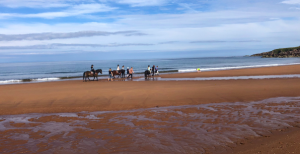
Public Bodies Fail to Respond
The private sector has been left to itself with little obvious effort by public bodies – with the exception of Lochcarron Community Council which ordered trowels for NC500 travellers to bury their waste by the side of the road. Campsites such as Glenmore which the Scottish Government has leased out on behalf of us all remain – scandalously – closed and for lack of access to greywater facilities, campervans have been disgorging the contents of their toilet tanks on roadside verges.
Some in the private sector have gone beyond what might have been expected of them. At Kinlochewe, on the NC500, the community took over the public toilets from the council which had locked them, and opened them themselves with a cleaning rota and a donation box for supplies. Karen Twist of the Kinlochewe Hotel said: “As a community, we want to help visitors be responsible and we need the toilets to be open. So we put up 850 pounds to buy the items we needed such as hand sanitizer and we have a donation box to keep it going.” Grateful travellers are responding.
Councils were very slow to open public toilets. Advice to campsite owners has resulted in many remaining closed to tent campers, increasing the verge-side issues. The Scottish Government’s late announcement of the date it was opening up the Highlands came too late for the Caravan Club which decided a few days prior that it would move its warders to English sites and keep the Scottish ones closed for the season. That has meant a loss of viable greywater facilities. In Kinlochewe, where one of the sites is, people were predicting weeks ago that campers would end up dumping sewage as a result but there was no way for them to share these concerns.
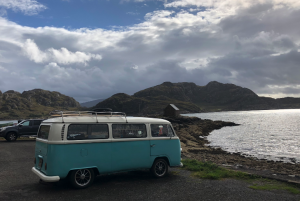
Edward Mountain, a Conservative MSPs and convenor of Holyrood’s Rural Economy committee, said he lobbied midway through the pandemic for planning requirements to be waived so that farmers could set aside fields for a couple of months for a more controlled version of wild camping: “They could have charged a small fee, provided basic facilities, and most importantly of all, they could have taken the details of who was in the area for the track and trace system. That was dismissed out of hand. As it is, there is no record of who is coming into these rural areas. There are not enough facilities. Many campsites and toilets are still closed or partially closed. Glenmore is a case in point. The Scottish Government owns that site but the company that holds the lease has refused to open despite the fact that the facilities there are vital for managing the situation.
“Campervans have nowhere to dump their wastewater – I have been lobbying for some time for the Cairngorms National Park to open a greywater facility in Granton but there is currently nowhere in that area and regrettably some of the vans are dumping the contents of their toilet tanks in laybys.
“People are camping in small village lay bys, overlooking people’s homes. I have constituents who phone me regularly saying their bedrooms and gardens are being overlooked by campervans. Nobody wants that.”
The Cairngorms National Park doesn’t directly manage any facilities but it has hired some wardens to manage the numbers. Peter Crane, head of visitor services, said: “We are trying to get people to have a plan B and move to a less popular area if there is no parking at their first choice. We have recruited eight rangers to deal with the situation. They are very engaging and persuasive people and are able to deal with most issues. However, we have had to call the police and the fire service because some people are lighting fires in woodland or peatlands and refusing to put them out.”
There is still plenty of room, however. Crane tweeted recently: “A few parts of #Cairngorms were very busy today but on my 10-mile bike ride on minor roads, tracks & promoted paths I met 5 walkers, one cyclist and two cars – there’s still plenty of quiet bits in a place nearly twice the size of Luxembourg.”
What Scotland could learn from the US
The Scottish Government could learn a lot from the US. There every state and national park has huge wilderness camping facilities. Pitches are widely spaced. At most of the ones we have visited, each pitch is equipped with a metal fire ring for a campfire and you can buy a bag of logs and matches from the ranger station. The campfire is a lovely part of the outdoor experience and they can be managed safely. Rangers are often older retired people who volunteer in return for benefits such as free electric hookups for their mobile homes. Many parks have outside arenas where on summer evening saucer-eyed children and relaxed parents listen to talks on subjects such as the night sky, the mountains, flora and fauna.
Scotland’s WIlderness Belongs to Everyone
Scotland’s rural areas belong to everyone. The pandemic exposed some divisions that were already there – such as between people who have to earn their living from hospitality and people who have retired to beauty spots and don’t want visitors spoiling the view. The media coverage fuelled a sense that ‘locals’ – ie those who live in these places are more entitled to decide what happens to them than people who don’t. But that’s a crude distinction – lots of people who have a deep love of the Highlands and a strong connection to them don’t have the option of living there full time. The debate became acrimonious in some areas – young friends on the NC500 recently saw a large sign reading ‘tourists go home’.
But the occasional nastiness won’t change the fact the river has flipped. People want to get out of the cities and as a society, instead of denouncing them and locking the toilets, Scotland should grasp the opportunity to extend environmental education and affordable camping facilities to all who need them.
The concern might have been appearing to encourage campers to come up to the Highlands, but ignoring the problem isn’t a solution. There are voices calling for fines for littering and so forth. I don’t personally think that is a solution – it’s not obvious who will leave litter until they have gone. And fining people on low incomes is a risky strategy – too many women have been jailed for non-payment of fines.
The new-found interest in the wilderness could be seen instead as an opportunity to reach out to our party-mad teens – the ones who normally disgrace themselves on the strip on Magaluf out of our sight. It is seeing people modelling the right behaviours, caring for Scotland’s wild places, that will show them better ways.
On the positive side, the weather has been on the whole, good. Many have had a great time. And that doesn’t just include the people – the midges have had a terrific season, feasting royally on tourist blood.
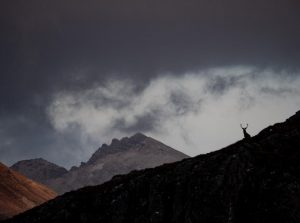
Photos by Rob Bruce
(except the ponies on Redpoint beach and the campervan – JK)
